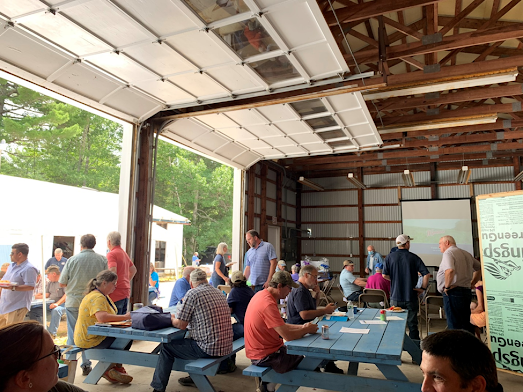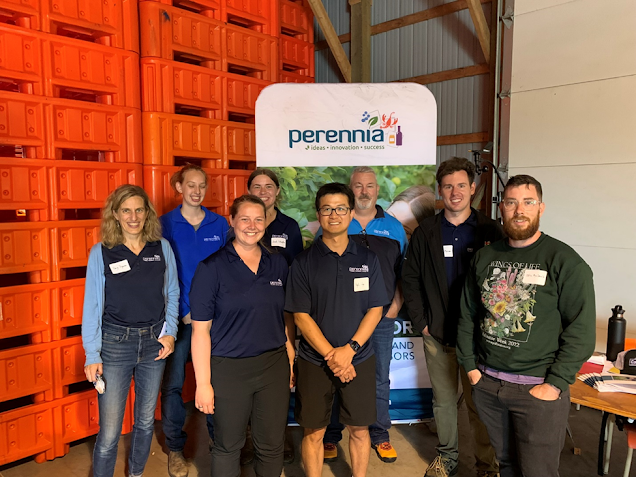BLUE
FOCUS NEWSLETTER- July 2022
(Perennia’s
Wild Blueberry Newsletter)
Dear Growers,
July is a busy and exciting month for
the industry. While we are waiting for harvesting season to start, field days in
different productions brought growers and industry partners together and
reconnected. I attended field days in Maine, NS and NB and the overall feedback
on this year’s production is good with decent yield potential prediction. The
heat wave and high temperatures in the province promote good crop development
but we are approaching dry conditions and adequate moisture is needed for
sizing berries.
I hope everyone has a great
harvesting season!
Hugh Lyu
Wild Blueberry Specialist, Perennia
hlyu@perennia.ca; 902-890-0472.
July 29, 2022
Table of Contents:
NS
Wild Blueberry Growing Degree Days Update
Wild Blueberry Industry Updates
Upcoming Management Recommendations
Government Programs
Upcoming Events and Courses
2022
Wild Blueberry Field Days Highlights
NS Wild Blueberry Growing Degree Days Update
Please see the below graph for the most updated
accumulation of GDD information from weather stations in wild blueberry fields
(Figure 1. GDD- July 28, 2022). The average accumulation GDD (since April 1)
from 22 stations was 1493 on July 28. Under the wild
blueberry GDD model, we are at 90% tip dieback stage (GDD- 1475) in sprout fields.
We don’t have GDD information for mature fruits and harvesting schedules under
the model, but based on other regions’ models and field observations, we are
about 1.5-2 weeks away from harvesting. Some receiving stations are scheduled
to open in the second week of August.
Figure 1. GDD- July 28, 2022
Wild Blueberry
Industry Updates
The growing conditions for all wild blueberry
production regions are decent this year.
In Nova Scotia, we didn’t get significant winter
damage and spring frost events. The warm dry spring also resulted in very low
disease this season. We had early bloom with some good pollination weather in
many areas. However, there was a cool and windy period in the middle of bloom
which could impact pollination efficiency in the impacted regions. Weed
pressures are another yield reduction factor for our crop. As we are
approaching harvesting and experiencing this heat wave across the province, adequate
moisture is critical for our crop. Currently, the industry is predicting 50
million lbs for Nova Scotia.
Other regions also have good production and the
dryness is one of the things concerning other regions as well, especially in
Maine.
Yield potential prediction:
Nova Scotia: 50 million lbs (2021: 49.5 million lbs)
Maine: 90 million lbs
(2021: 103.8 million lbs)
Quebec: 80 million lbs (2021: 36.3 million lbs)
New Brunswick: 55 million lbs (2021: 55.8 million lbs)
PEI: 20 million lbs
(2021: 19.5 million lbs)
Upcoming Management
Recommendations
Crop fields:
1. Insects,
trapping for SWD and Blueberry Maggot:
I haven’t heard reports about SWD and
blueberry maggots in the northern regions/fields, but in the Annapolis Valley
area, they are seeing both SWD and blueberry maggots.
- To trap and understand
SWD: https://www.perennia.ca/wp-content/uploads/2020/02/SWD-factsheet_March2020.pdf.
- For blueberry maggot:
Yellow rectangles coated with sticky material and an attractive bait are used
for monitoring the blueberry maggot. When the first capture is found, it is
better to give a few days for more adults to emerge.
Please remember to check products’
pre-harvest interval and check with your processor before you apply products in
fields.
Sprout fields:
1. Leaf
rust control in sprout fields: the goal of applying fungicides this time of the
year in sprout fields is to keep the leaves on blueberry plants as soon as they
can in the fall. This would help to keep plants healthy and for better fruit
buds.
2. Leaf
tissue and soil sampling: if growers want to collect tissue and samples for
analysis, it is a good time to do that now (tip-dieback stage). Here are two resources
to help with sampling and interpretation of the reports:
a. Soil
and leaf sampling in wild blueberry production: https://www2.gnb.ca/content/dam/gnb/Departments/10/pdf/Agriculture/WildBlueberries-BleuetsSauvages/D10E.pdf.
b. Nova
Scotia Wild Blueberry Leaf Nutrient Ranges: https://www.perennia.ca/wp-content/uploads/2018/04/wbb-leaf-nutrient-ranges.pdf.
3. Red
leaf disease: we are seeing more red leaf disease in both sprout and crop
fields. In crop fields, this disease will cause early leaves and fruit drops.
There are no control products for this disease. We ask growers to avoid
spreading spores (white patches on the underside of infected leaves) by not
walking through the diseased area.
Figure
2. Red leaf
Government Programs
NSDA- Blueberry Pollination Expansion Program
The Blueberry
Pollination Expansion Program helps Nova Scotia beekeepers to expand their
operations and increase the number of honeybee hives available for blueberry
pollination in the province.
Details and application
of the program: https://novascotia.ca/programs/Blueberry-Pollination-Expansion/. Application deadline: August 31, 2022.
NSDA- Food and Beverage Business Accelerator Program
The Food and Beverage Business Accelerator Program
provides support for Nova Scotian food and beverage producers to access
services provided by Perennia. Perennia's services can help food and beverage
producers to improve their skills, access new markets, launch new products and
develop new ideas for by-products.
Details and application of the program: https://novascotia.ca/programs/Food-Beverage-Business-Accelerator-Program/.
Application deadline: November 30, 2022.
Upcoming Events and
Courses
Please check out the event page under
the wild blueberry blog for more details. http://www.novascotiawildblueberryblog.com/p/events.html
University of Maine: Wild Blueberry Production: A Five
Week Course for Beginning Farmers
This course is an
introduction to growing wild blueberries in Maine. The course covers field
selection, agronomics, integrated pest management, pollinators, climate change
challenges, economics, and an introduction to how this industry functions. The
course includes one field trip during class time to observe an established
blueberry field. This class is open to current students, and beginning and
established farmers.
To register for the
course, please visit: https://extension.umaine.edu/register/product/wild-blueberry-production-short-course-2022/
2022 Wild Blueberry Field Days
Highlights
This year, most productions hosted their in-person field days in mid-July. I didn’t go to the one in Quebec but I was able to make it to Maine, NS and NB’s field days. Here are some photos from field days. Thank you for attending WBPANS’ field days in East River Saint Marys!
Maine Wild Blueberry Field Day- Jonesboro,
July 14, 2022
Open-top chambers for wild blueberry research
Grasshopper Harvester demo- Pictou County Berry Ltd.
Biochar-compost
Demo
WBPANS Wild Blueberry Field Day- East River Saint
Marys, July 19, 2022
Perennia Group
New electrical weeder
(Weed Zapper) Demo
Drs. Scott White and
Travis Esau, introduce Weed Zapper and weed management
New Brunswick Wild Blueberry Field Day- Aulac, July
21, 2022













